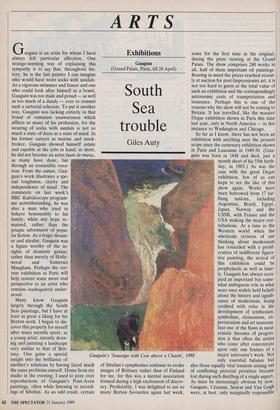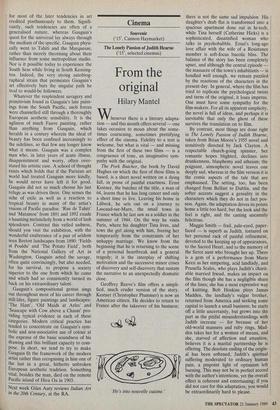ARTS
Exhibitions
Gauguin (Grand Palais, Paris, till 24 April)
South Sea trouble
Giles Auty
auguin is an artist for whom I have always felt particular affection. One strange-seeming way of explaining this sympathy is to say that, throughout his- tory, he is the last painter I can imagine who would have worn socks with sandals.
As a vigorous swimmer and fencer and one who could look after himself in a brawl, Gauguin was too male and proud — as well as too much of a dandy — ever to commit such a sartorial solecism. To put it another way, Gauguin was lacking entirely in that brand of ruminant unawareness which afflicts so many of his profession, for the wearing of socks with sandals is not so much a state of dress as a state of mind. In his former careers as marine and stock- broker, Gauguin showed himself astute and capable at the jobs in hand; in short, he did not become an artist faute de mieux, as many have done, but through an irresistible voca- tion. From the outset, Gau- guin's work illustrates a spe- cial toughness, clarity and independence of mind. The comments on last week's BBC Kaleidoscope program- me notwithstanding, he was also a man who tried to behave honourably to his family, while any hope re- mained, rather than the priapic adventurer of popu- lar fiction. As a tragic dream- er and idealist, Gauguin was a figure worthy of the in- sights of dramatic genius, rather than merely of Holly- wood and Somerset Maugham. Perhaps the cur- rent exhibition in Paris will help restore some more real perspective to an artist who remains inadequately under- stood.
Many know Gauguin largely through the South Seas paintings, but I have at least as great a liking for his Breton work. I began to dis- cover this properly for myself after many months spent, as a young artist, intently draw- ing and painting a landscape very similar to that of Brit- insight into the brilliance of another's solutions by having faced much the same problems oneself. Home from my studio in the evening, I used to pore over reproductions of Gauguin's Pont-Aven paintings, often while listening to record- ings of Sibelius. As an odd result, certain of Sibelius's symphonies continue to evoke images of Brittany rather than of Finland for me, for this was a mental association formed during a high excitement of discov- ery. Predictably, I was delighted to see so many Breton favourites again last week, some for the first time in the original, during the press viewing at the Grand Palais. The show comprises 280 works in all, half of them important oil paintings. Bearing in mind the prices reached recent- ly at auction for post-Impressionist art, it is not too hard to guess at the total value of such an exhibition and the correspondingly astronomic costs of transportation and insurance. Perhaps this is one of the reasons why the show will not be coming to Britain. It has travelled, like the massive Degas exhibition shown in Paris this time last year, only in North America — in this instance to Washington and Chicago.
So far as I know, there has not been an exhibition with anything near the present scope since the centenary exhibition shown guin was born in 1848 and died, just a month short of his 55th birth- day, in 1903.) As was the case with the great Degas exhibition, few of us can hope to see the like of this show again. Works have been borrowed from 17 far- flung nations, including Argentina, Brazil, Egypt, Japan, Norway and the USSR, with France and the USA making the major con- tributions. At a time in the Western world when the wholesale revision of our thinking about modernism has coincided with a prolif- eration of indifferent figura- tive painting, the arrival of this exhibition could be prophylactic as well as time- ly. Gauguin has always occu- pied an important but some- what ambiguous role in what were once widely held beliefs about the history and signifi- cance of modernism, being credited with roles in the development of synthesism, symbolism, cloissonism, ex- pressionism and art nouveau. Just one of the flaws in mod- ernistic theories of progres- sion is that often the artists who come after concentrate upon only one feature of a 1988 major innovator's work. Not only essential balance but also those equally vital tensions arising out of conflicting pictorial priorities become lost during such distilling of a single aspect. As must be increasingly obvious by now, Gauguin, Cezanne, Seurat and Van Gogh were, at best, only marginally responsible for most of the later tendencies in art credited posthumously to them. Signifi- cantly, such tendencies are often of a generalised nature, whereas Gauguin's quest for the universal lay always through the medium of the specific. Gauguin physi- cally went to Tahiti and the Marquesas, rather than merely theorising about their influence from some metropolitan studio. Nor is it possible today to experience the South Seas while living in South Kensing- ton. Indeed, the very strong autobiog- raphical strain that permeates Gauguin's art effectively bars the singular path he trod to would-be followers.
Whatever the resplendent savagery and primitivism found in Gauguin's late paint- ings from the South Pacific, such forces were channelled still through a thoroughly European aesthetic sensibility. It is the ugliness of much Fauve painting, rather than anything from Gauguin, which heralds in a century wherein the ideal of beauty has been confined increasingly to the sidelines, so that few any longer know what it means. Gauguin was a complex man who, in later years of acute illness, disappointment and worry, often over- stated his artistic case. A school of thought exists which holds that if the Parisian art world had treated Gauguin more kindly, he would never have left it for good. Gauguin did not so much choose his last refuge as was driven there. One senses the ache of exile as well as a reaction to tropical beauty in many of the artist's visions of Pacific paradise; `Rue de Tahiti' and `Matamoe' from 1891 and 1892 exude a haunting melancholy from a world of lush splendours. Contrast this veiled sadness, should you visit the exhibition, with the wonderful exuberance of a pair of seldom seen Breton landscapes from 1890: 'Fields at Pouldu' and 'The Potato Field', both from the National Gallery of Art in Washington. Gauguin acted the savage, often quite convincingly, but also needed, for his survival, to propose a society superior to the one from which he came and which had so consistently turned its back on his extraordinary talent.
Gauguin's compositional genius sings out throughout most of his career through still-lifes, figure paintings and landscapes: The Ham', 'Old Maids at Arles' and 'Seascape with Cow above a Chasm' pro- viding typical evidence in each of these categories. Modern critical practice has tended to concentrate on Gauguin's sym- bolic and non-associative use of colour at the expense of the basic soundness of his drawing and this brilliant capacity to com- pose. In short, we tend to try to make Gauguin fit the framework of the modern artist rather than recognising in him one of the last in a great, hitherto unbroken European aesthetic tradition. Something vital, besides the man, died on the remote Pacific island of Hiva Oa in 1903.
Next week Giles Auty reviews Italian Art in the 20th Century, at the RA.



























































 Previous page
Previous page